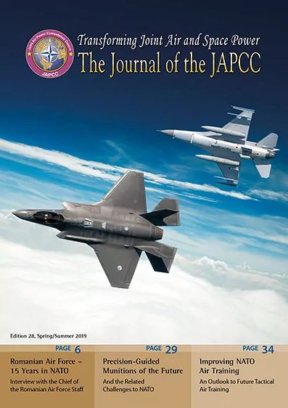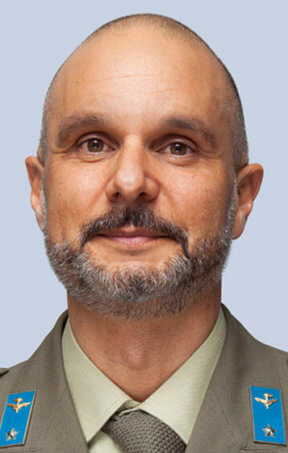Sir, thank you for taking the time to answer some questions and to provide an insight into Italian Army Aviation. Can you please describe the current posture of Italian Army Aviation?
Over the last thirty years, without interruption, Italian Army Aviation has been employed in missions abroad and has operated in a broad spectrum of geographic and climatic locations. Army Aviation has adapted to combat multidimensional threats which are very different from the threats they were originally trained to fight. Across the globe, the most significant missions have been in Bosnia and Kosovo in the European theatre, Somalia and Mozambique in the African theatre, Iraq and Lebanon in the Middle East and Afghanistan and East Timor in Asia. Thanks to the service’s collective operational experience, it has been possible to develop and introduce a new family of weapon systems and aircraft into service. These systems and aircraft were designed from the ground up to allow Army Aviation greater flexibility and survivability. Army Aviation is an important operative enabler of the Armed Forces and an amazing resource for the nation. Army Aviation is always ready and at the forefront of all operations conducted in both national and international territories. Italian Army Aviation emphasizes the concept of ‘dual-use’, meaning we are trained and equipped to handle the full spectrum of military operations as well as support to civil security for the population. Firefighting campaigns, emergency medical support and search and rescue are only a few of the tasks in which we are involved on a daily basis. Army Aviation is a modern force which operates technologically advanced equipment, in combined-force operations and international arenas. Army Aviation provides a host of capabilities, which generate security while supporting progress and prosperity at a national and international level. Our crews are multi-skilled with a remit to conduct transport (Air Movement, Tactical Transport and MEDical EVACuation [MEDEVAC]), Attack (Close Air Support, Close Combat Attack), direction and control of fire, Command, Control and Communication (C3) support, personnel recovery and Reconnaissance, Surveillance and Target Acquisition (RSTA). I can confidently state, that Italian Army Aviation today stands fully capable of conducting a wide spectrum of missions in any environment and weather condition, and is ready to fulfil the needs of Italy and the NATO Alliance.
In your opinion, will the tiltrotor-aircraft replace helicopters in the near future?
Tiltrotors carry similar-sized payloads to transport helicopters but fly much faster and with longer range. I believe they will be a possible alternative, but only for the replacement of utility/medium-lift helicopters. Most likely, in the near future, tiltrotors will enable a wide spectrum of transport like airborne, air movement and MEDEVAC missions. However, as far as combat helicopters are concerned, I believe the possible choices will only be between ‘conventional’ and ‘coaxial rigid-rotor’ helicopters. This is because combat helicopters need to be much more manoeuvrable, not only for air-to-air and air-to-ground combat but also to enable hovering; i.e. enabling masking and unmasking in crucial combat and target acquisition phases of flight. This is the reason why, coherently, we are now starting to develop a new eight-ton class attack helicopter, which will provide Italian Army Aviation with an increased technological advantage, greater performance and lower operating costs. This will meet the diverse mission requirements of future conflict for the next 30 years or more.
Considering a hypothetical near-peer enemy conflict, characterized by a lack of airspace supremacy and being affected by capable Electronic Warfare (EW), hybrid or cyberattack; is Italian Army Aviation ready for this? How would you prepare your personnel to meet these kinds of threats?
It is known that our potential peer adversaries have consistently invested in EW modernization across the electromagnetic (EM) spectrum. Moreover, they demonstrate a remarkable capability in hybrid and cyber environments and are ready to infiltrate, exploit and degrade access to our networks and data. So, of course, if I have to hypothesize a conflict and I must consider their capabilities to target our Command, Control, Communications, Computers, Intelligence, Surveillance and Reconnaissance (C4ISR), most likely with packages capable of inhibiting or degrading the use of our frequencies and operating systems. We must be fully prepared to fight in this environment. For this reason, Italian Army Aviation, following NATO’s advice and instructions, is concentrating its EW efforts on two pillars: development and training. We are developing our ability to prevent, detect, defend against, and recover from a complex attack by working closely with military authorities, agencies and industry to keep our helicopters, and all the systems used by Army Aviation for storing, coordinating, and protecting information, updated and effective. To increase our level of training, we have been conducting a new training method called Complex Airmobile Exercise (CAEX). It is a Live Exercise/Field Training Exercise (LIVEX/FTX), which is held every year in two or three sessions at Brigade level. In these exercises, we include Opposing Forces (OPFOR) and reproduce typical operational contexts, which replicate the same operational stress that the crews may encounter when deployed. We created an EW/cyber/hybrid scenario which forces crews to operate with minimized radio communications and without the use of Global Positioning System (GPS) signals, thereby forcing use of on-board backup systems like Doppler and the Air Data System (ADS) for navigation. Also, during planning phases with ground forces, they practice visual signals for coordinating fire support. This innovative and advanced training programme was conceived and developed to verify and validate techniques, tactics, operating procedures and standardization of different Italian Army assets through various aerial missions (e.g., Quick Reaction Force, Quick Reaction Action, Personnel Recovery, MEDEVAC, Air Assault). No country can face an EW/cyber/hybrid scenario threat alone. We are stronger when we work with our international partners. Consequently, we share intelligence, combine forces and coordinate responses to develop new, effective tools, technologies and strategies to make our organization resilient to cyber, hybrid and EW attacks. Ultimately, in my opinion, you cannot survive on the modern battlefield unless you are truly competitive in these areas.
How can Army Aviation develop and improve air-to-land integration?
Thanks to the ongoing Services Industry NATO-sponsored activities, such as the Joint Capabilities Group Vertical Lift (JCGVL) and the Study Group-227 Manned-Unmanned Teaming (NIAG SG-227 MUM-T), a new roadmap was developed for ATP-49G (operations). This is to address the requirements for high speed, long-range and extended-endurance Next Generation Rotorcraft (NGR) insertion, with high-autonomy Unmanned Aerial Systems (UAS). It is envisaged that these rotorcraft will operate in Restricted Operating Zones (ROZ), with both, manned aircraft or Optionally Piloted Vehicles (OPV) roles at all phases of operations. In the future, Army Aviation will operate over large areas of responsibility, providing combat and scout capabilities. With these newly-developed procedures, we will ensure the development and improvement of air/land integration. This will include a long-range data link capability, which will accelerate the ability to deliver timely C3 and intelligence information to all commanders at tactical, operational and strategic levels. The air assault operational capabilities, first tested during the European Defence Agency (EDA) Exercise ‘Italian Blade 2015’, have been used as the basis to introduce new possible Manned Unmanned Teaming (MUM-T) capabilities in the Army Aviation operational segment. During this exercise, a Level of Interoperability (LOI) 3 capable Rotorcraft Unmanned Aerial System/Optionally Piloted Helicopter (RUAS/OPH) was integrated via Ground Control Station with Attack Helicopters (AHs), Utility Helicopters UHs and a ground Joint Terminal Attack Controller (JTAC). Besides doctrine, procedures and effectively incorporated training, a reasonably good level of integration requires at least the availability of effective Command and Control capabilities, improved situational awareness and reliable communication systems. To that end, we are sure that the right application of technology will play a key role in the future to closely connect air, sea and land portions of the battlefield and to allow crews and personnel to operate with maximum safety, reduced risk and higher levels of efficiency.
Where do you see Army Aviation in 20 years?
Army Aviation has to keep in mind that it has been, and absolutely will be in the future, a key enabler for Army and joint missions. It brings unique capabilities to fulfil mission requirements across the full spectrum of Army military operations. For example, the development of an integrated airmobile component in an Italian Army Aviation airmobile brigade gives flexibility, manoeuvrability and timely responsiveness to orders from the ground force Commander. Army Aviation has been, and will remain, the principal way to provide ground forces with fire, mobility, and intelligence capabilities. We must be prepared to focus combat power on multiple targets, on short notice to move, and ensure a sustainable capability to rapidly provide logistics support to manoeuvre forces. The ability to quickly deploy, build, and sustain combat power will remain at the vanguard of our unique capability. Army Aviation will be critical across the full spectrum of operations and fully integrated within joint, interagency, and multinational frameworks. A transformation process has begun and will develop Army Aviation in the years to come, with the aim to improve operational and logistics functions, including related organizational structures. This will increase lethality, agility and versatility. The goal is a networked force, capable of providing a wide range of options across the full spectrum of conflict. We have to retain conventional war capabilities along with very well trained and educated personnel who can fight across this wide spectrum. Personnel must be able to adapt rapidly to threats, especially in the cyber, hybrid and EW domains, when radio, standard navigation systems, and tactical links are severely degraded. In the end, the ability of our personnel and equipment to operate effectively in various environments will determine the success or failure of the mission.












